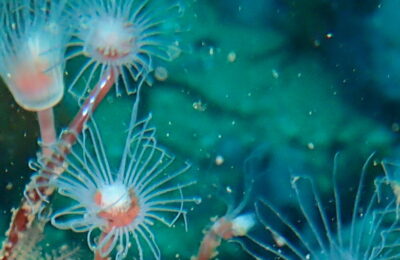Article: Boström-Einarsson, L., et al. (2014). “Habitat degradation modifies the strength of interspecific competition in coral dwelling damselfishes.” Ecology 95(11): 3056-3067.
http://dx.doi.org/10.1890/13-1345.1
Background:
Competition is a fundamental component of ecology. Whether among individuals of the same species (intraspecific competition) or between individuals of different species (interspecific competition), competition helps shape and structure communities. Competition occurs over resources, and depending on what kind of organism you are, resources vary. In marine environments, species compete for food, nutrients, space, and light, among others. Competition is also highly density dependent, meaning that the number of individuals present has an impact on the intensity of competition.
Coral reefs support highly diverse communities. Covering less than 1% of the world’s oceans, they house about 25% of all marine species. Reefs provide complex habitat, refuge, and food; but supporting so many species in such a small area also means that there is a lot of competition for resources (Fig 1). Previous research has shown that competition for space within reefs can influence the structure of fish communities. For example, competitively dominant fish species can actually increase the death rate of less dominant species by restricting access to preferred space, leaving the weaker fish open to predation.

Coral reefs are fragile habitats. We often hear about bleaching events, coral disease, or dynamite fishing wreaking havoc on reefs and their inhabitants. Additionally, the future doesn’t look great for reefs as warming and more acidic oceans are going to impact the health of these ecosystems. So how does degradation of reefs affect competition? A few theories have been proposed:
- Greater limitation of resources will ramp up competition
- Competitive hierarchies could switch, meaning the more submissive species would start to outcompete the dominant species – this would happen if the submissive species weren’t as negatively effected by the changing habitat
- Degradation could create new competitive rivals if resources started overlapping
These theories have yet to be experimentally tested…until now. A group of researchers out of Australia decided to test how competition between two damselfish species was impacted by degradation of their reef habitat.
The Study:
Researchers from James Cook University set up a field manipulation to study the competition between two common damselfish species: Chrysiptera parasema (Fig 2) and Dascyllus melanurus (Fig 3). These two species occupy the same ecological niche and rely on live coral for habitat as juveniles. Previous studies have shown D. melandrus to be competitively dominant over C. parasema. Knowing that competition among these fish is density dependent, researchers included a density component in this study.


Experimental plots were established in field sites of the coast of Papua New Guinea. Researchers used one species of coral, Acropora longicyathus (Fig 4), at two levels of health, either 100% healthy or 10% healthy. Plots were established on sandy bottoms away from other reefs. They were created by transplanting the appropriate amount of live and recently dead coral to their plots, plots were 0.5m X 0.5m. Once the coral plots were established, researchers anesthetized, collected, and tagged (for monitoring) individual juvenile fish of both species and transplanted them onto one of their plots. Numbers of individuals of both species varied between plots in order to test the density dependence factor as well as gather information on both inter and intraspecific competition. Stocks of fish ranged from 10-40 fish per plot. Over the course of 60 days, researchers observed plots for mortality, movement between plots, and behavior and interactions of fish within a plot.

Overall, researchers found that competition between species was stronger on healthy reefs resulting in an increase in C. parasema mortality with increasing competitor abundance, thus it was density dependent (Fig 5). The interspecific competition yielded higher mortality in C. parasema than the intraspecific competition. However, on degraded reefs, impacts from both inter and intraspecific competition were completely altered. Mortality rates were similar on all these reefs despite competitor abundance; meaning in degraded reefs, competition and mortality was density independent. Behaviorally, degraded reefs resulted in increased “agnostic interactions” (or interactions defined as a nip or chase by one fish to another) with increased abundance (Fig 6). Making it seem as though the fish in degraded habitats were more “on edge”, and were more interactive.


The Significance:
In a typical, healthy reef, competition between fish is density dependent and the competitively dominant species will ultimately win out. This competition is a structuring ecological force that has allowed species to adapt to roles and niches. But ecosystems like coral reefs are vulnerable to degradation. This research is the first to look at how habitat degradation impacts competition, showing that when a habitat is degraded, all of the density dependence and competition is thrown out the window. These established relationships between species crumble under these conditions. It is important to note that although the competition and density dependence factor are a wash, mortality in these fish increases with degraded habitat, it’s just not linked to the same factors. With reefs threatened from a number of sources in the future, we may soon be seeing a new set of rules (or lack thereof) come into play. Competition is a key process in regulating populations and communities, and it appears that this process is lost in a degraded system.
This review ties nicely in with another recent oceanbites post that focuses on behavioral changes in damselfish in degraded reefs. By interweaving these two studies we can start to paint a broader picture of how reef destruction and degradation is impacting individuals, communities, and interactions.
Postdoctoral Researcher, Claremont McKenna College
I am currently a postdoc at Keck Sciences, Claremont McKenna College. I work with Dr. Sarah Gilman, measuring and modeling energy budgets in intertidal species. I am a climate scientist and marine community ecologist and my PhD (University of Rhode Island) focused on how ocean acidification and eutrophication, alters coastal trophic interactions and species assemblages.
I love bad jokes and good beer.

